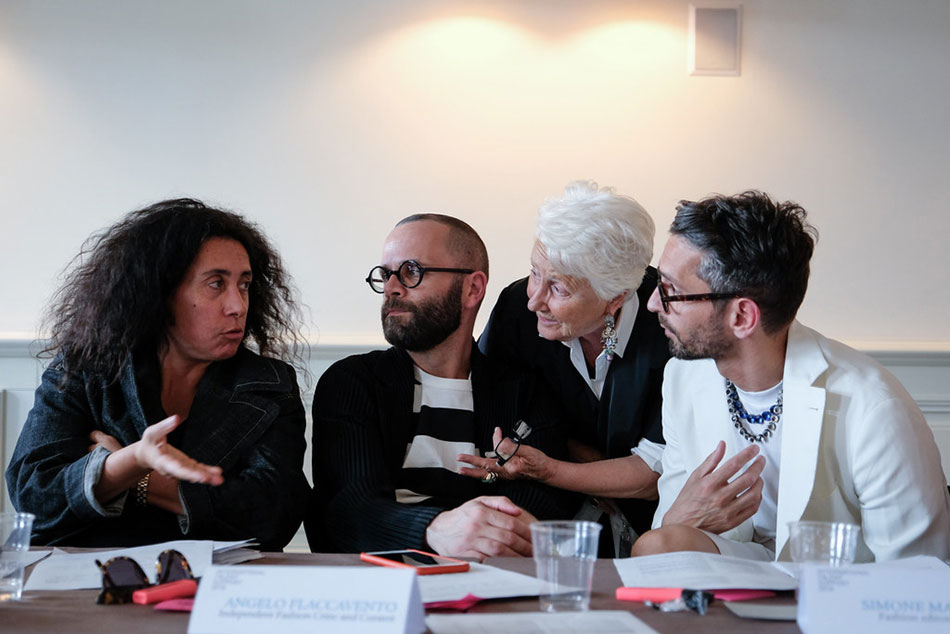
Deanna Ferretti Veroni started her career in Reggio Emilia, Italy more than 50 years ago. She has since then successfully collaborated with some of the most important designers of this past century. She met Kenzo when she was barely 25 years old and worked with him successfully for over 20 years. During the 70s she collaborated with Yves Saint Laurent (for Tricot and Variation), Rena Kraft, Chiwitt, Frapp, Luis London, Blaky Dress, Giorgio Correggiari, Popy Moreni and Michelle Bruyere. In the 80s she produced for Adrienne Vittadini, Armani and Joseph: collections that were drawn by the likes of Galliano and Richmond. In the 90s, she worked for Martin Margiela, Gai Mattiolo, Valentino, Neil Barrett and many other brands. With a wide experience in textiles and knitwear, she cannot be called neither a fashion designer nor simply a business woman. Actually, she is an atypical figure born to realize (almost) every designer’s dream. Today, every three or four years her company supports a new young talent. Deanna also continues to collaborate with several schools and always loves to work with young people. She is a symbol of originality and quality.

ITS: Before knitwear who was Deanna and what was she doing? When did you realize that this would be your profession?
DF: I got into knitwear at a very, very young age, when I graduated from a professional school in Reggio Emilia. I decided I would learn how to operate a knitting machine and with the help of expert knitters I took my first steps into this world. Knitting textiles with my own hands really fascinated me so I plunged into professional courses to learn more. Very soon I was asked to teach and that’s basically how my knitwear career began.
ITS: Were there moments in your career when you told yourself “this is enough, I am quitting and I want to do something else” and if so, what would you have liked to do?
DF: I dreamed of becoming a soubrette like Delia Scala, who was my role model since I was a little girl. She belonged to a rare kind of versatile, complete artists who could act, dance and perform in movies, on TV or at the theatre.
Of course, there were tough moments indeed, but I love challenges and quitting is not in my DNA. I like to finish what I start, for better or for worse. I was lucky to pick a job I’ve always deeply loved so maybe that is the reason I never gave up.

ITS: Looking at those professional qualities which made your career so unique, which one do you consider as the most important, without which making it would have been impossible?
Tough question, you would have to ask to those I’ve collaborated with… I’m quite tenacious for sure, my curiosity is boundless and good intuitions led me to trust the right people at the right moment. My husband first of all.
Among those who contributed to my professional and personal growth I cannot but mention my meeting with Kenzo Takada in 1971. He was the first designer I ever collaborated with. Kenzo introduced me to an international and creative fashion world, we grew together both professionally and as human beings. We worked so much together, but we never stopped having fun.
I’ve learned something important from each one of “my designers”, through endless exchanges of ideas, emotions and creativity. Martin Margiela for instance – he has a special place in my heart as well – taught me a completely new perspective on fashion and knitting. He pushed me to leave my boundaries and comfort zone to embrace a philosophy I knew nothing about, risking, daring and experimenting.
ITS: What is the future of knitwear in an industry that is called towards a responsible creativity aiming at reducing to zero the impact on the planet?
The future of knitwear is in the journey – it has already started in Italy – towards a more sustainable production chain and more ecological processes. Several companies in my area are already certified and work hard to make their products less and less impactful. I have hope, there is a lot to do but something is already moving in the right direction. It will certainly take time, revolutions are not made in one night, but things will improve.
